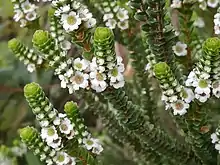Baeckea imbricata
Baeckea imbricata, commonly known as heath myrtle, is a heathland shrub found in coastal areas and nearby ranges in New South Wales and Queensland in Australia. It grows to 1 metre high and has small ovate leaves that are 3–6 mm long and 2.5 to 5 mm wide. White flowers appear between spring and late summer.[2]
| Baeckea imbricata | |
|---|---|
 | |
| Palm Beach, New South Wales, Australia | |
| Scientific classification | |
| Kingdom: | Plantae |
| Clade: | Tracheophytes |
| Clade: | Angiosperms |
| Clade: | Eudicots |
| Clade: | Rosids |
| Order: | Myrtales |
| Family: | Myrtaceae |
| Genus: | Baeckea |
| Species: | B. imbricata |
| Binomial name | |
| Baeckea imbricata | |
The species was formally described by German botanist Joseph Gaertner in 1788, based on a specimen at the herbarium of Joseph Banks. Gaertner gave the new species the name Jungia imbricata.[3] In 1917 the species was transferred to the genus Baeckea by British botanist George Claridge Druce.[1] The specific epithet imbricata is derived from Latin, referring to the overlapping leaves.[4]
References
- "Baeckea imbricata (Gaertn.) Druce". Australian Plant Name Index (APNI), IBIS database. Centre for Plant Biodiversity Research, Australian Government. Retrieved 18 March 2014.
- Wilson, Peter G. "New South Wales Flora Online: Baeckea imbricata". Royal Botanic Gardens & Domain Trust, Sydney, Australia.
- "Jungia imbricata Gaertn". Australian Plant Name Index (APNI), IBIS database. Centre for Plant Biodiversity Research, Australian Government. Retrieved 18 March 2014.
- Les Robinson – Field Guide to the Native Plants of Sydney, ISBN 978-0-7318-1211-0 page 25
This article is issued from Wikipedia. The text is licensed under Creative Commons - Attribution - Sharealike. Additional terms may apply for the media files.